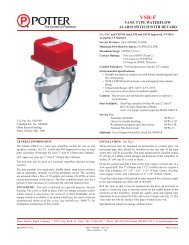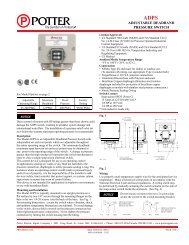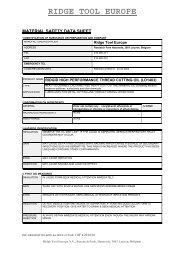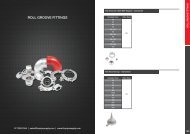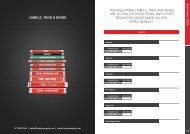Please refer to website - Firepipe Supply
Please refer to website - Firepipe Supply
Please refer to website - Firepipe Supply
You also want an ePaper? Increase the reach of your titles
YUMPU automatically turns print PDFs into web optimized ePapers that Google loves.
MOLYTEC AUSTRALIA, Unit 1, 9 Steel St, Capalaba, QLD Australia, 4157<br />
Tel. for Information: (07) 3245 2355<br />
Fax for Information: (07) 3245 2499<br />
Last Updated: April 2008<br />
Page 2 of 3<br />
Material Safety Data Sheet<br />
MOLYTEC Liquid Spanner Aerosol<br />
7. Safe Handling Information<br />
S<strong>to</strong>rage:<br />
-S<strong>to</strong>re in original containers in approved flameproof area<br />
-DO NOT s<strong>to</strong>re in pits, depressions, basements or areas where vapours may be trapped.<br />
-No smoking, naked lights, heat or ignition sources.<br />
-Keep containers securely sealed. Contents under pressure.<br />
-S<strong>to</strong>re away from incompatible materials.<br />
-S<strong>to</strong>re in a cool, dry, well ventilated area in an upright position out of direct sunlight.<br />
-Avoid s<strong>to</strong>rage at temperatures higher than 40°C<br />
-Protect containers against physical damage and check regularly for leaks.<br />
8. Exposure Control and Personal Protection<br />
Exposure Limits No exposure standards have been established for this material. Exposure standards<br />
recommended by NOHSC for some ingredients are as follows:<br />
Name STEL TWA<br />
Propane<br />
Asphyxiant<br />
Butane<br />
800ppm<br />
Turpentine substitute 790mg/m³<br />
Ethyl Acetate 1400mg/m³ 400ppm<br />
Engineering Controls Use in well ventilated areas. Ensure ventilation is adequate <strong>to</strong> maintain air concentrations<br />
below Exposure Standards. Use with local flameproof exhaust ventilation or while wearing<br />
organic vapour respira<strong>to</strong>r. Vapour is heavier than air – prevent concentrations in hollows or<br />
sumps. DO NOT enter confined spaces where vapour may have collected. Explosive gas<br />
atmospheres may form, for further information <strong>refer</strong> <strong>to</strong> AS 2430.<br />
Personal Protection Where ventilation is not adequate, respira<strong>to</strong>ry protection may be required. An approved organic<br />
Respira<strong>to</strong>r Type vapour respira<strong>to</strong>r should be used. Respira<strong>to</strong>ry protection should comply with AS/NZS 1715 and<br />
AS/NZS 1716<br />
Eye Protection<br />
Safety glasses or chemical goggles. Failure <strong>to</strong> do so may result in eye damage if an accident<br />
occurs. Consult AS 1336 & AS/NZ 1337 for information about eye protection.<br />
Glove Type<br />
Available information suggests gloves made of nitriles, vi<strong>to</strong>n, neoprene or other similar solvent<br />
resistant material. Keep solvent contact <strong>to</strong> a minimum. For help in selecting suitable gloves<br />
consult AS2161<br />
Clothing<br />
Overalls or similar protective clothing. Consult AS 2919 for advice.<br />
Always wash hands before smoking, eating, drinking, or using the <strong>to</strong>ilet. Wash contaminated<br />
clothing and other protective equipment before s<strong>to</strong>ring or re-using.<br />
Flammability<br />
-Heat or damage <strong>to</strong> containers may release flammable gases<br />
Fire Hazards<br />
-Containers will explode when heated – ruptured containers will rocket<br />
-Released gases may form explosive mixtures with air in confined spaces<br />
-Released gases may travel <strong>to</strong> source of ignition and flash back<br />
-Organic chemicals may form flammable dust clouds in air; will burn if involved in fire<br />
-Fire may produce irritating, poisonous and/or corrosive gases.<br />
9. Physical and Chemical Properties<br />
Appearance & Odour:<br />
Clear brown liquid<br />
Boiling Point:<br />
between 77° <strong>to</strong> 195°C (for liquid concentrate)<br />
Specific Gravity:<br />
0.78 (for liquid concentrate)<br />
Solubility in Water:<br />
Soluble (for liquid concentrate)<br />
Vapour Pressure:<br />
400Kpa @ 25°C (propane/butane blend propellant)<br />
Flash Point:<br />
-17°C (propane/butane blend propellant)<br />
Flamm. Limits:<br />
1.5% <strong>to</strong> 9.6% in air (v/v)(propane/butane blend propellant)<br />
Au<strong>to</strong>ignition temp:<br />
494°C <strong>to</strong> 600°C (propane/butane blend propellant)<br />
PH:<br />
Not Available<br />
Percent volatiles: approximately 70%<br />
10. Stability and Reactivity<br />
-Vapour is highly flammable<br />
-Severe fire hazard when exposed <strong>to</strong> heat or flame<br />
-Vapour forms explosive mixture with air<br />
-Vapour may travel considerable distance <strong>to</strong> source of ignition<br />
-Heating may cause expansion with violent container rupture<br />
-Aerosol cans may explode on exposure <strong>to</strong> naked flames<br />
-Rupturing containers may rocket and scatter burning materials<br />
-Hazards may not be restricted <strong>to</strong> pressure effects<br />
-Organic chemicals may form flammable dust clouds in air; will burn if involved in fire<br />
-May emit acrid, poisonous or corrosive fumes<br />
-On combustion, may emit <strong>to</strong>xic fumes of carbon monoxide (CO)<br />
-Other combustion products include carbon dioxide (CO2)<br />
Conditions <strong>to</strong> avoid: See “Safe Handling Information” (Section 7).<br />
LIQUID SPANNER M890



